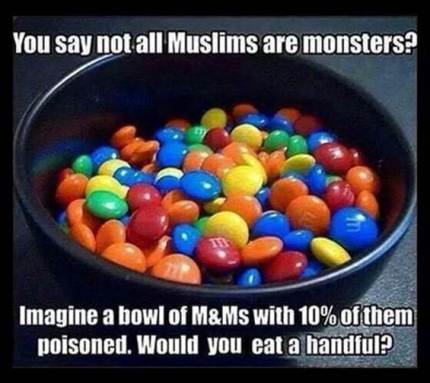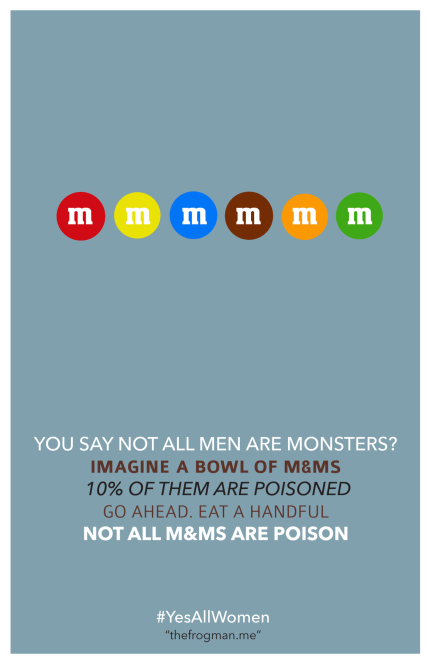You’ve seen it a thousand times. In all likelihood, you’ve probably seen it employed by vastly different demographics. Which I find amazingly strange, because one would think that when on the receiving end of this utterly worthless reductive argument, one immediately and intuitively realizes just how deeply flawed it is. So I can see why one would then turn it around and wield it ironically, reductio ad absurdum, as a joke.
But then to use it seriously? To have the stupid thing proliferate through internet discourse? It’s completely unfathomable to me.
So let’s get to it. It looks something like this:

Or, it goes like this:

Or maybe, like this:

You get the idea.
This “argument,” if you can call it that without gagging, is used and abused by tons of people in very different camps, all the time. It’s another classic piece of rubbish recycled rhetoric, something that gets slapped on an image that can be circulated and go viral when people see it and already agree so they hit the share button, because simple arguments don’t make brain go ow.
Let’s examine the point, with an ounce of charity, to boil down what it’s trying to get across.
The Attempted Point:
You have a sample of a thing, say X, and a smaller number of that larger sample, Y, is hazardous in some way. The numbers seem to vary a bit depending on who’s using them (10%, or apparently even 0.1%) in terms of wha portion of the sample in question is hazardous. The supposition here is that even if the hazardous sample is incredibly small, you’ll hesitate to take a random sample of the larger sample when you’re playing with your life (the implication being eating a poisoned M&M kills you, I suppose).
Now, if I haven’t made it clear already, I’m really having a hard time believing I really even need to write this post. It’s frankly somewhat shocking that it’s not so patently obvious how shitty this argument is that people wouldn’t immediately realize and abandon it. But, much to my continued dismay, and to the continued knee-capping of social discourse, it still lives. And especially since it’s so egregiously bad, there’s a duty here to dismantle it, for the good of our ability to reason as a society. Sigh.
Why It’s Garbage
10% isn’t very much. There’s a decent chance that in any sample of just about anything, that 10% of that sample sucks. So, let’s go reductio ad absurdum first. You basically just need a stereotype, and you stick it in the formula, and ta-dah, you have your stereotype affirming BS argument.
- You say not all white kids are school shooters? Imagine a bowl of M&M’s. 10% of them are poisoned. Go ahead, eat a handful. Not all M&M’s are poison, and not all white kids are school shooters.
- You say not all conservatives want to shoot up abortion clinics? M&M’s
- You say not all conservatives are closet racists? M&M’s.
- You say not all liberals want to ban all guns? M&M’s.
- You say not all cops want to kill black people? M&M’s.
- You say not all black people want to kill cops in retaliation? M&M’s.
- You say not all black people are criminals? M&M’s.
I hope you get the picture. This rhetoric can be used to apply to literally any stereotype about a general demographic you can think of. It’s basically a catch-all argument for stereotyping. And therefore bigotry. Last time I checked, bigotry was bad. Following?
Second approach. How about that .1% huh? That’s a really, really low number. Are we really going to balk at that? I can maybe understand, theoretically, not wanting to play Russian roulette with a 10 chamber gun. But one bad apple in a thousand? Let’s take a minute and look at some statistics, for perspective.

(Source: http://www.nsc.org/learn/safety-knowledge/Pages/injury-facts-chart.aspx)
So, if we’re not risking anything with more than a 1/1,000 chance of death, don’t get in a car. Or on a motorcycle. In fact, don’t go near roads, since lots of pedestrians are killed. Don’t keep any sharp objects or pills in the house, because you just might off yourself. Also you sure as shit better switch to an all kale and quinoa diet, because heart disease and cancer, damn. Just to be safe, don’t go near any body of water, since drowning is pretty darn close to 1/1000 deaths.
Look, goofy statistics aside, the point is you take risks in your life every day when you get out of bed. Hell there’s probably a pretty small statistical chance that getting out of bed will kill you, and you do that a whole lot. Maybe you should stop risking that, since you risk your life every time you do.
Life is risk, folks. There are no 100% safety assurances on anything. And if that’s what you want, go lock yourself in a rubber room and strap into your bubble suit.

I really hope that’s about enough to wrap this up. But do me a favor, next time you see anyone, regardless of whether you happen to agree with their point, use this argument, tell them it’s BullShit and they shouldn’t be using it. Because it’s bad rationale, and every time it’s used it enables other people to use it as a form of rhetoric for some equally shitty point. Even if you happen to be using it to support a otherwise tenable position, using it alone is an issue.
If you’re too lazy to explain why the argument is shit, just copy the link to this post on the person’s stupid picture or comment. I don’t mind the site traffic.
Rubbish Ranking:
I’ve also decided that if I keep going forward with these types of posts, I’m going to start ranking how shitty these pieces of rhetoric are. Factors in their shittiness are as follows:
- How prevalent is the rhetoric? The more common it is, the worse the ranking.
- How shitty is the argument? Is it never usable? Would it be alright in some circumstances, but sometimes it’s misused?
- How much overall impact and damage does the rhetoric have on people’s likelihood to think through the issue?
So, without further ado, I give The M&M Argument:

“A Blight on Human Discourse!” This godforsaken thing is horribly common, and even when the position it’s supposedly defending is solid, it does damage. It not only stops people from thinking, but encourages people to use stereotyping and hasty generalization as methods of evaluating problems. Huge no-no.
I’m also going to retro-actively go back and rate Rubbish Recycled Rhetoric #1: “Nobody Blamed the Lightsaber” so go ahead and check that out if you haven’t already.